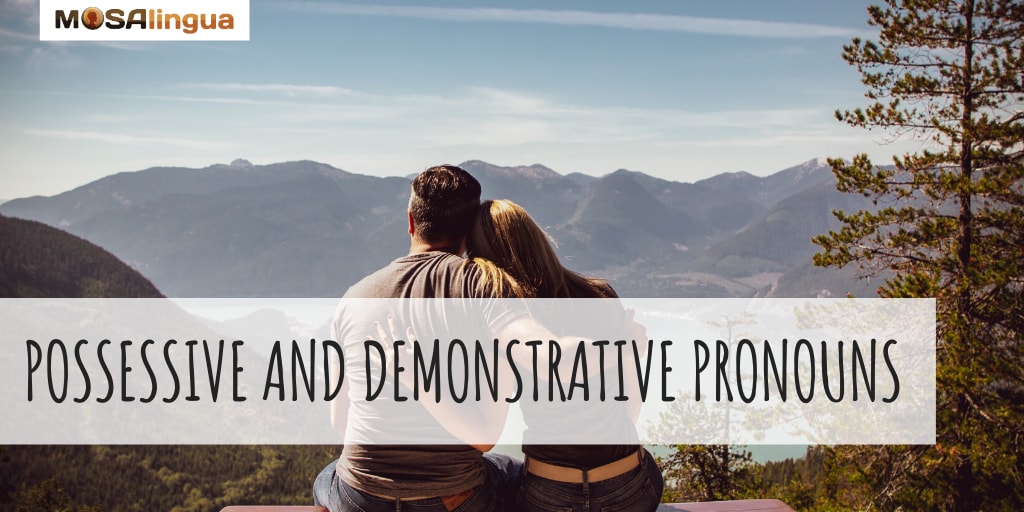We’re back, with another lesson on English grammar! Nothing too complicated, but definitely important: possessive pronouns and demonstrative pronouns in English. They’re used in a similar way to most languages. Let’s have a closer look, and learn the right way to use them.

Indicating Possession in English
In English, there are 3 ways to indicate possession: possessive determiners, possessive pronouns, and possessive apostrophes (‘s).
Possessive determiners: My cat, your dog, his horse
The first form of possession uses determiners. These are pronouns that come at the beginning of a sentence or noun phrase, to indicate possession. Gender in English is unlike that of Romance languages, so there is just one word for each determiner, except for the third person singular:
- First person singular possession: my
- Second person singular possession: your
- Third person singular possession:
- his or her, based on the gender of the person to whom the object belongs (his for a male, and her for a female). This is different from Romance languages, where the determiner changes based on the object that is possessed, not the person who possesses it.
- its, when referring to inanimate objects or animals (unless you know the animal’s gender), but it is incorrect to use it for people.
- First person plural possession: our
- Second person plural possession: your
- Third person plural possession: their
The noun that comes after the determiner is the possessed object; the determiner indicates the possessor. Let’s look at some examples:
Her boyfriend is older than she is.
In this case, “boyfriend” is the possessed object, and the third person singular (her) is the possessor. It’s similar to son copain in French, il suo fidanzato in Italian, o namorado dela in Portuguese, and ее молодой человек in Russian, except the determiner is feminine since the person who has the boyfriend is a woman.
My kitchen has been redone.
Here, “kitchen” is the possessed object, and the first person singular is the possessor. Kind of like ma maison in French, la mia cucina in Italian, minha cozinha in Portuguese, and моя кухня in Russian (except “my” has no gender).
Your shirt is dirty.
Finally, “shirt” is the possessed object, and the second person singular is the possessor.
Start improving your English today

Good news: we can help!
More good news: you can get started for free! With your free trial, you can test drive the most effective method for learning English for the next 15 days!
Vocabulary flashcards, videos with subtitles, audiobooks, articles adapted to your level – with MosaLingua Premium (Web & Mobile), you’ll have access to all this and more. Get started right now. It’s free—and risk-free—to try!
Possessive pronouns: That house is mine/yours/his
As in most languages, if you’ve already said the name of the thing we possess, rather than repeat it, you can use possessive pronouns. These are pronouns that replace the possessed object in the sentence. In English, they are:
- First person singular: mine
- Second person singular: yours
- Third person singular:
- his or hers, based on the gender of the possessor.
- Its for inanimate objects and animals (quite rare). Don’t use its for people.
- First person plural: ours
- Second person plural: yours
- Third person plural: theirs
Examples:
Her cat is cuter than his.
His is the possessive pronoun in this sentence. It replaces: his cat. (Note that there are two pronouns in this sentence; her cat is a determiner-noun pair, like we saw above).
Have you seen a black jacket? It’s mine.
Mine is the possessive pronoun in this sentence. It replaces: my jacket.
Possessive apostrophes: My cat’s paw, the dog’s collar
Finally, one of the most popular ways to indicate possession in English is to add an apostrophe-s (‘s) to the name of the person or animal to whom the object belongs. For example:
It’s my father’s car.
The car belongs to my father.
The teacher’s son is handsome.
The son belongs to the teacher.
He threw out his sister’s homework.
The homework belongs to his sister.
If the possessor is plural, in which case the words ends with an -s, add only the apostrophe. For example: My cousins’ house is bigger than mine. The house belongs to my cousins.
Possessive apostrophes don’t exist in other languages, so they can take some getting used to. However, they are essential if you want to sound like a native speaker in English. Many non-native speakers, especially those who speak Romance languages (like French, Italian, Spanish or Portuguese) use “of” phrases to indicate possession, where a native speaker would use a possessive apostrophe. For example:
The dog of my sister.
This is grammatically correct — but it sounds awkward in English, and a native English speaker will pick up on it straight away. Instead, we say: My sister’s dog.
The son of the teacher is handsome.
Instead we say: The teacher’s son.
With the possessive apostrophe form, drop the first article and flip the order of the words.
English Possessive Hacks – Video
In the video below, our English teacher Abbe explains how to use possessive apostrophes correctly, and gives you a useful tip to make sure you always get it right. This video is also available on our YouTube channel. If you need to, turn on subtitles in English or 5 other languages, or slow down the playback speed. Just click on the settings (gear icon) on the bottom-right corner of the video.
Subscribe to our channel for more English grammar hacks and other language tips.
Demonstrative Pronouns in English
In English, there are 4 demonstrative pronouns: this, these, that and those.
The four demonstrative pronouns can be grouped into two sets: this and these, and that and those. The difference has to do with proximity. When we’re speaking about something that’s close, we use this and these. When speaking about something that’s farther away, we use that and those.
For a nearby object or person
Examples:
I grew up in this city.
The speaker is talking about the city around him — it’s close, so he uses this.
These are my parents.
The speaker is introducing her parents — they’re close, so she uses these.
For a distant object or person
Examples:
Look at that view!
The speaker is talking about a view in the distance, so he uses that.
Those kids are crazy.
The speaker is talking about kids that are farther away, so she uses those.
For comparison and emphasis
We also use this distinction to compare objects. We might say:
This hotdog tastes good, but that hotdog tastes amazing!
Here, the objects are being compared. We use this and that to distinguish them.
These cookies are mine, and those are yours.
Here, the speaker is emphasizing a distinction. We use these and those to make sure the person understands the difference (although you should always share your cookies!).
And there you have it! Now you know the basic rules of possessive and demonstrative pronouns in English. Now, make sure that you practice them often so that you use the right one at the right time. We’ll see you again soon for another English grammar lesson. In the meantime, check out these other helpful lessons:
- Our lesson on distinguishing between make and do
- Our lesson on using linking words in English
- This one, about talking about the past in English
- An essential lesson about talking about the present
- Our lesson on talking about the future in English
- And why English grammar is easy, to boost morale!
Did you find this article helpful? Leave us a comment below. We love to hear from you, and we’d be happy to answer any questions you have about English possessive and demonstrative pronouns.
Listen
You can also listen to the podcast version of this article with MosaLingua Language Lab:
Listen to “#30 – The Possessive in English | ENGLISH GRAMMAR HACKS” on Spreaker.



![Modern vs Traditional Learning Methods | Léa English [VIDEO]](https://www.mosalingua.com/en/files/2022/03/lea-english-interview-modern-and-traditional-learning-methods-300x150.jpg)
Comments